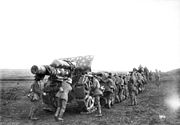
21 cm Mörser 16
Encyclopedia
The 21 cm Mörser 16 or langer 21 cm Mörser was a heavy howitzer
used by Germany
in World War I
and World War II
.
, but had a longer barrel
, a gun shield and other refinements. Originally it broke down into two loads for transport, but the Germans rebuilt surviving guns during the Thirties with rubber-rimmed steel wheels to allow for motor traction in one piece with a limber under the trail and generally removed the gunshield.
 In German service it used two shells, the 21 cm Gr 18 (HE
In German service it used two shells, the 21 cm Gr 18 (HE
) that weighed 113 kilograms (249.1 lb) and the 21 cm Gr 18 Be concrete-piercing shell of 121.4 kilograms (267.6 lb) with a filler of 11.61 kilograms (25.6 lb) of TNT.
They remained in first-line use with the Germans until replaced by the 21 cm Mörser 18
by about 1940. Afterwards they were used for training and equipped units in secondary theaters.
The Swedes bought a dozen weapons in 1918 from the Germans and they remained in service until 1950. The Swedes had their own concrete-piercing shells, the 210 tkrv 51/65-ps R-/33 weighing 120.75 kilograms (266.2 lb), which had dispersion problems as the Finns found out.
The Finns bought four of these from the Swedes during the Winter War
although they did not participate in the war because the Finns lacked vehicles strong enough to tow their great weight to the front. This had been rectified before the Continuation War
and the Finns equipped the 10th Separate Super-Heavy Artillery Battery with them for the duration of the war. They were put into reserve after the war and remained there until the late 1960s before being discarded.
Howitzer
A howitzer is a type of artillery piece characterized by a relatively short barrel and the use of comparatively small propellant charges to propel projectiles at relatively high trajectories, with a steep angle of descent...
used by Germany
Germany
Germany , officially the Federal Republic of Germany , is a federal parliamentary republic in Europe. The country consists of 16 states while the capital and largest city is Berlin. Germany covers an area of 357,021 km2 and has a largely temperate seasonal climate...
in World War I
World War I
World War I , which was predominantly called the World War or the Great War from its occurrence until 1939, and the First World War or World War I thereafter, was a major war centred in Europe that began on 28 July 1914 and lasted until 11 November 1918...
and World War II
World War II
World War II, or the Second World War , was a global conflict lasting from 1939 to 1945, involving most of the world's nations—including all of the great powers—eventually forming two opposing military alliances: the Allies and the Axis...
.
History
It was based on the earlier 21 cm Mörser 1021 cm Mörser 10
The 21 cm Mörser 10 was a heavy howitzer used by Germany in World War I. It replaced the obsolete 21 cm Mörser 99 that lacked a recoil system. For transport it broke down into two loads. Some howitzers were fitted with a gun shield during the war. As it was also intended for siege use a...
, but had a longer barrel
Gun barrel
A gun barrel is the tube, usually metal, through which a controlled explosion or rapid expansion of gases are released in order to propel a projectile out of the end at a high velocity....
, a gun shield and other refinements. Originally it broke down into two loads for transport, but the Germans rebuilt surviving guns during the Thirties with rubber-rimmed steel wheels to allow for motor traction in one piece with a limber under the trail and generally removed the gunshield.
Combat service

He
He is a third-person, singular personal pronoun in Modern English, as well as being a personal pronoun in Middle English.-Animals:...
) that weighed 113 kilograms (249.1 lb) and the 21 cm Gr 18 Be concrete-piercing shell of 121.4 kilograms (267.6 lb) with a filler of 11.61 kilograms (25.6 lb) of TNT.
They remained in first-line use with the Germans until replaced by the 21 cm Mörser 18
21 cm Mörser 18
The 21 cm Mörser 18 was a German heavy howitzer used in the Second World War by independent artillery battalions and batteries. A number were also used by coast defense artillery units.-Design & History:...
by about 1940. Afterwards they were used for training and equipped units in secondary theaters.
The Swedes bought a dozen weapons in 1918 from the Germans and they remained in service until 1950. The Swedes had their own concrete-piercing shells, the 210 tkrv 51/65-ps R-/33 weighing 120.75 kilograms (266.2 lb), which had dispersion problems as the Finns found out.
The Finns bought four of these from the Swedes during the Winter War
Winter War
The Winter War was a military conflict between the Soviet Union and Finland. It began with a Soviet offensive on 30 November 1939 – three months after the start of World War II and the Soviet invasion of Poland – and ended on 13 March 1940 with the Moscow Peace Treaty...
although they did not participate in the war because the Finns lacked vehicles strong enough to tow their great weight to the front. This had been rectified before the Continuation War
Continuation War
The Continuation War was the second of two wars fought between Finland and the Soviet Union during World War II.At the time of the war, the Finnish side used the name to make clear its perceived relationship to the preceding Winter War...
and the Finns equipped the 10th Separate Super-Heavy Artillery Battery with them for the duration of the war. They were put into reserve after the war and remained there until the late 1960s before being discarded.

